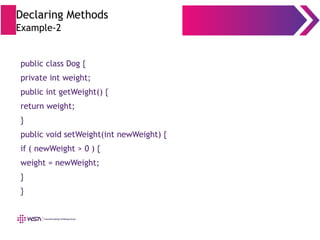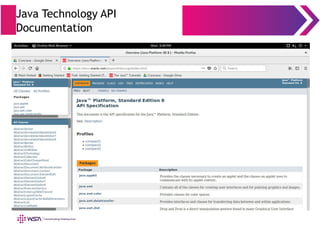Core Java Programming Language (JSE) : Chapter II - Object Oriented Programming.
Object-oriented programming (OOP) refers to a type of computer programming (software design) in which programmers define not only the data type of a data structure, but also the types of operations (functions) that can be applied to the data structure. In this way, the data structure becomes an object that includes both data and functions. In addition, programmers can create relationships between one object and another. For example, objects can inherit characteristics from other objects. If you are new to object-oriented programming languages, you will need to know a few basics before you can get started with code. The following definitions will help you better understand object-oriented programming: Abstraction: The process of picking out (abstracting) common features of objects and procedures. Class: A category of objects. The class defines all the common properties of the different objects that belong to it. Encapsulation: The process of combining elements to create a new entity. A procedure is a type of encapsulation because it combines a series of computer instructions. Information hiding: The process of hiding details of an object or function. Information hiding is a powerful programming technique because it reduces complexity. Inheritance: a feature that represents the "is a" relationship between different classes. Interface: the languages and codes that the applications use to communicate with each other and with the hardware. Messaging: Message passing is a form of communication used in parallel programming and object-oriented programming. Object: a self-contained entity that consists of both data and procedures to manipulate the data. Polymorphism: A programming language's ability to process objects differently depending on their data type or class.










![Declaring Attributes
●
Basic syntax of an attribute:
<modifier>* <type> <name> [ = <initial_value>];
●
Examples:
public class Foo {
private int x;
private float y = 10000.0F;
private String name = "Bates Motel";
}](https://image.slidesharecdn.com/002javaseoops-190429124524/85/Core-Java-Programming-Language-JSE-Chapter-II-Object-Oriented-Programming-11-320.jpg)







![Declaring Constructors
●
Basic syntax of a constructor:
[<modifier>] <class_name> ( <argument>* ) {
<statement>*
}
●
Example:
public class Car {
private int speed;
public Car() {
speed = 50;
}
}](https://image.slidesharecdn.com/002javaseoops-190429124524/85/Core-Java-Programming-Language-JSE-Chapter-II-Object-Oriented-Programming-19-320.jpg)

![Source File Layout
● Basic syntax of a Java source file is:
[<package_declaration>]
<import_declaration>*
<class_declaration>+](https://image.slidesharecdn.com/002javaseoops-190429124524/85/Core-Java-Programming-Language-JSE-Chapter-II-Object-Oriented-Programming-21-320.jpg)


![The package Statement
●
Basic syntax of the package statement is: package
– <top_pkg_name>[.<sub_pkg_name>]*;
●
Examples of the statement are:
– package shipping.gui.reportscreens;
●
Specify the package declaration at the beginning of the source file.
●
Only one package declaration per source file.
●
If no package is declared, then the class is placed into the default
package.
●
Package names must be hierarchical and separated by dots.](https://image.slidesharecdn.com/002javaseoops-190429124524/85/Core-Java-Programming-Language-JSE-Chapter-II-Object-Oriented-Programming-24-320.jpg)
![The import Statement
● Basic syntax of the import statement is:
Import<pkg_name>[.<sub_pkg_name>]*.<class_name>;
OR
import<pkg_name>[.<sub_pkg_name>]*.*;
● Examples of the statement are:
import java.util.List;
import java.io.*;
import shipping.gui.reportscreens.*;](https://image.slidesharecdn.com/002javaseoops-190429124524/85/Core-Java-Programming-Language-JSE-Chapter-II-Object-Oriented-Programming-25-320.jpg)







Recommended




























![Lec 5 13_aug [compatibility mode]](https://cdn.slidesharecdn.com/ss_thumbnails/lec513augcompatibilitymode-130917012559-phpapp02-thumbnail.jpg?width=560&fit=bounds)
![Lec 5 13_aug [compatibility mode]](https://cdn.slidesharecdn.com/ss_thumbnails/lec513augcompatibilitymode-130917012559-phpapp02-thumbnail.jpg?width=560&fit=bounds)




























More Related Content
What's hot (19)












![Lec 5 13_aug [compatibility mode]](https://cdn.slidesharecdn.com/ss_thumbnails/lec513augcompatibilitymode-130917012559-phpapp02-thumbnail.jpg?width=560&fit=bounds)
![Lec 5 13_aug [compatibility mode]](https://cdn.slidesharecdn.com/ss_thumbnails/lec513augcompatibilitymode-130917012559-phpapp02-thumbnail.jpg?width=560&fit=bounds)


























Similar to Core Java Programming Language (JSE) : Chapter II - Object Oriented Programming. (20)








![Lec 4 06_aug [compatibility mode]](https://cdn.slidesharecdn.com/ss_thumbnails/lec406augcompatibilitymode-130917012610-phpapp01-thumbnail.jpg?width=560&fit=bounds)
![Lec 4 06_aug [compatibility mode]](https://cdn.slidesharecdn.com/ss_thumbnails/lec406augcompatibilitymode-130917012610-phpapp01-thumbnail.jpg?width=560&fit=bounds)






















More from WebStackAcademy (20)








































Recently uploaded (7)








Core Java Programming Language (JSE) : Chapter II - Object Oriented Programming.
- 1. www.webstackacademy.com ‹#› Java Programming Language SE – 6 Module 2 : Object-Oriented Programming
- 2. Objectives ● Define object modeling concepts: abstraction,encapsulation and packages ● Discuss why you can reuse Java technology application code ● Define class, member, attribute, method, constructor, and package ● Use the access modifiers private and public as appropriate for the guidelines of encapsulation ● Invoke a method on a particular object ● Use the Java technology application programming interface (API) online documentation
- 3. Relevance ● What is your understanding of software analysis and design? ● What is your understanding of design and code reuse? ● What features does the Java programming language possess that make it an object-oriented language? ● Define the term object-oriented.
- 5. The Analysis and Design Phase ● Analysis describes what the system needs to do: Modeling the real-world, including actors and activities, objects, and behaviors ● Design describes how the system does it: – Modeling the relationships and interactions between objects and actors in the system – Finding useful abstractions to help simplify the problem or solution
- 6. Abstraction ● Functions – Write an algorithm once to be used in many situations ● Objects – Group a related set of attributes and behaviors into a class ● Frameworks and APIs – Large groups of objects that support a complex activity; Frameworks can be used as is or be modified to extend the basic behavior
- 7. Classes as Blueprints for Objects ● In manufacturing, a blueprint describes a device from which many physical devices are constructed. ● In software, a class is a description of an object: – A class describes the data that each object includes. – A class describes the behaviors that each object exhibits.
- 8. Classes as Blueprints for Objects ● In Java technology, classes support three key features of object- oriented programming (OOP): – Encapsulation – Inheritance – Polymorphism
- 9. Declaring Java Technology Classes ● Basic syntax of a Java class: <modifier>* class <class_name> { <attribute_declaration>* <constructor_declaration>* <method_declaration>* }
- 10. Declaring Java Technology Classes public class Vehicle { private double maxLoad; public void setMaxLoad(double value) { maxLoad = value; } }
- 11. Declaring Attributes ● Basic syntax of an attribute: <modifier>* <type> <name> [ = <initial_value>]; ● Examples: public class Foo { private int x; private float y = 10000.0F; private String name = "Bates Motel"; }
- 12. Declaring Methods Basic syntax of a method: <modifier>* <return_type> <name> ( <argument>* ) { <statement>* }
- 13. Declaring Methods public class car{ private int modelno; private String colour; public void dispInfo(int mno,String col) { modelno=mno; colour=col; } }
- 14. Declaring Methods Example-2 public class Dog { private int weight; public int getWeight() { return weight; } public void setWeight(int newWeight) { if ( newWeight > 0 ) { weight = newWeight; } }
- 15. Accessing Object Members ● The dot notation is: <object>.<member> ● This is used to access object members, including attributes and methods. ● Examples of dot notation are: ● a.dispInfo(101,”green”); ● a.modelno=”101”;
- 16. Example // create a class car that will display the model number and colour of car. class car { int modelno; String colour; void dispInfo(int mno,String col) { modelno = mno; colour = col; } }
- 17. Example -2 class carTest { car c1=new car(); c1.dispInfo(101,”green”); } }
- 18. Encapsulation ● Hides the implementation details of a class ● Forces the user to use an interface to access data ● Makes the code more maintainable CarCar colour String model_no int disp_info() void Move() void
- 19. Declaring Constructors ● Basic syntax of a constructor: [<modifier>] <class_name> ( <argument>* ) { <statement>* } ● Example: public class Car { private int speed; public Car() { speed = 50; } }
- 20. The Default Constructor ● There is always at least one constructor in every class. ● If the writer does not supply any constructors, the default constructor is present automatically: – The default constructor takes no arguments – The default constructor body is empty ● The default enables you to create object instances with new Xxx()without having to write a constructor.
- 21. Source File Layout ● Basic syntax of a Java source file is: [<package_declaration>] <import_declaration>* <class_declaration>+
- 22. Source File Layout package shipping.reports; import shipping.domain.*; import java.util.List; import java.io.*; public class VehicleCapacityReport { private List vehicles; public void generateReport(Writer output) {...} }
- 23. Software Packages ● Packages help manage large software systems. ● Packages can contain classes and sub-packages.
- 24. The package Statement ● Basic syntax of the package statement is: package – <top_pkg_name>[.<sub_pkg_name>]*; ● Examples of the statement are: – package shipping.gui.reportscreens; ● Specify the package declaration at the beginning of the source file. ● Only one package declaration per source file. ● If no package is declared, then the class is placed into the default package. ● Package names must be hierarchical and separated by dots.
- 25. The import Statement ● Basic syntax of the import statement is: Import<pkg_name>[.<sub_pkg_name>]*.<class_name>; OR import<pkg_name>[.<sub_pkg_name>]*.*; ● Examples of the statement are: import java.util.List; import java.io.*; import shipping.gui.reportscreens.*;
- 26. The import Statement The import statement does the following: ● Precedes all class declarations ● Tells the compiler where to find classes
- 27. Compiling Using the -d Option cd JavaProjects/ShippingPrj/src javac -d ../classes shipping/domain/*.java
- 28. Recap ● Class – The source-code blueprint for a run-time object ● Object – An instance of a class; also known as instance ● Attribute – A data element of an object; also known as data member, instance variable, and data field ● Method – A behavioral element of an object; also known as algorithm, function, and procedure
- 29. Recap ● Constructor – A method-like construct used to initialize a new object ● Package – A grouping of classes and sub-packages
- 30. Java Technology API Documentation ● A set of Hypertext Markup Language (HTML) files provides information about the API. ● A frame describes a package and contains hyperlinks to information describing each class in that package. ● A class document includes the class hierarchy, a description of the class, a list of member variables, a list of constructors, and so on.
- 32. Thank You







